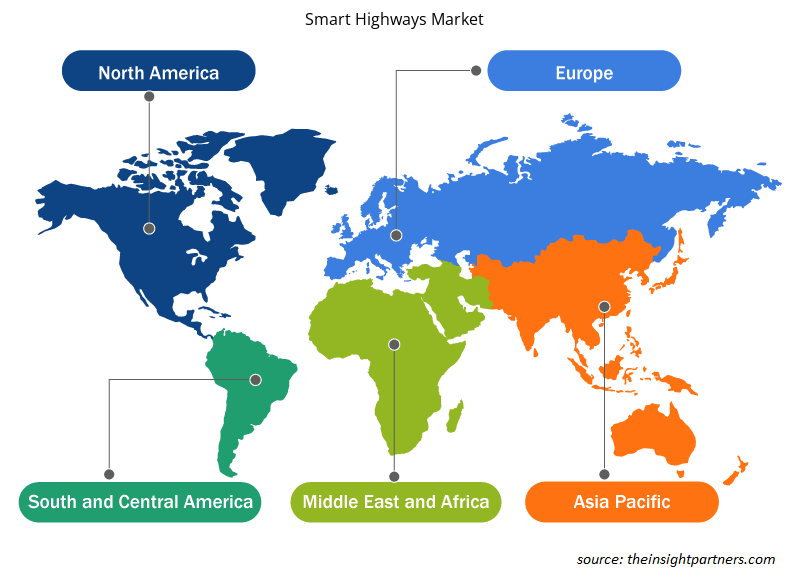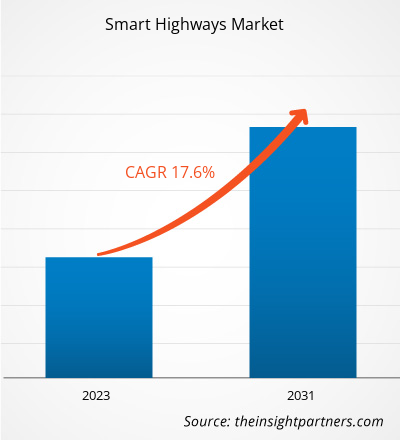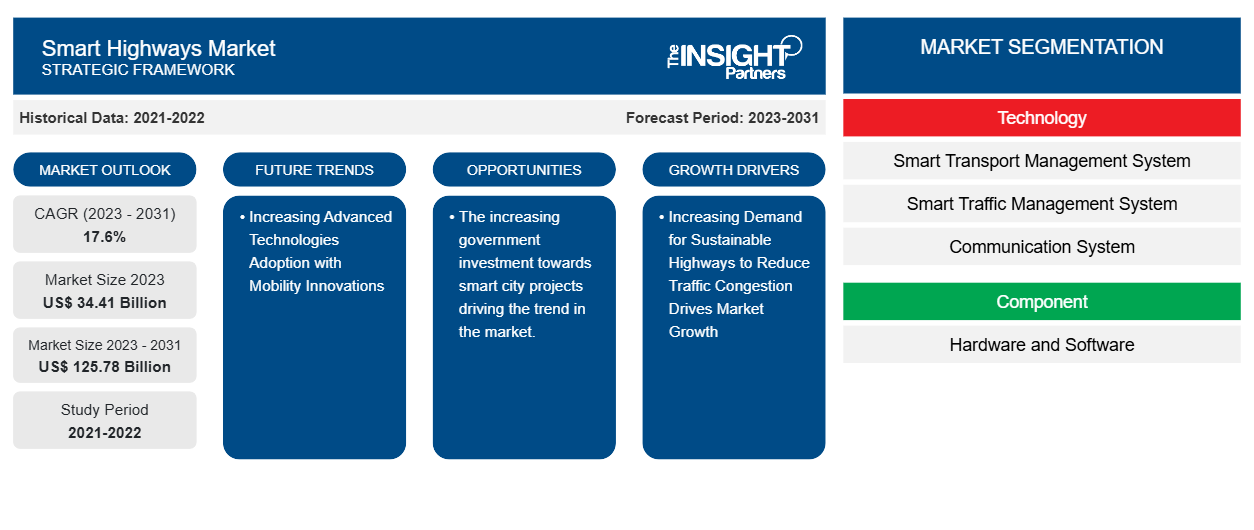من المتوقع أن يصل حجم سوق الطرق السريعة الذكية إلى 125.78 مليار دولار أمريكي بحلول عام 2031 من 34.41 مليار دولار أمريكي في عام 2023. ومن المتوقع أن يسجل السوق معدل نمو سنوي مركب بنسبة 17.6٪ خلال الفترة 2023-2031. إن المبادرات الحكومية المتزايدة لتطوير المدن الذكية تدفع نمو السوق. إن زيادة اعتماد التقنيات المتقدمة لإنشاء المدن الذكية في جميع أنحاء العالم هو اتجاه دافع في السوق.
تحليل سوق الطرق السريعة الذكية
إن زيادة تطوير الطرق السريعة الذكية مع دمج التقنيات المتقدمة، مثل الذكاء الاصطناعي وإنترنت الأشياء والأجهزة المتصلة، في طرق النقل يدفع نمو سوق الطرق السريعة الذكية. هناك هيئات حاكمة مختلفة تخطط لتعديل مساراتها، وخاصة الطرق السريعة لدعم أنظمة النقل الذكية والبنية التحتية للطرق في جميع أنحاء العالم. على سبيل المثال، في أوروبا، تم بناء أنظمة النقل الذكية التعاونية للطرق الذكية التي تسمح لمستخدمي الطرق ومديري المرور بتنسيق وتبادل المعلومات المفيدة حول أنشطة الطرق.
نظرة عامة على سوق الطرق السريعة الذكية
إن زيادة تبني وتطوير مشاريع " المدينة الذكية " في المناطق الحضرية مع دمج شبكة أجهزة استشعار واسعة النطاق لتعزيز الاتصال الأفضل يدفع نمو السوق. تخضع المدن الذكية في جميع أنحاء العالم لتغييرات كبيرة لجعل حياة المواطنين أفضل وأكثر كفاءة وصديقة للبيئة. ومن المتوقع أن تعزز الابتكارات مثل بناء المدن الذكية سوق الطرق السريعة الذكية بشكل كبير في السنوات القادمة.
بفضل المشاريع من القطاعين العام والخاص، تشهد مدينة نيويورك حاليًا تحولًا رقميًا باستخدام أحدث التقنيات التي توفرها إنترنت الأشياء والأجهزة المتصلة.
قم بتخصيص هذا التقرير ليناسب متطلباتك
ستحصل على تخصيص لأي تقرير - مجانًا - بما في ذلك أجزاء من هذا التقرير، أو تحليل على مستوى الدولة، وحزمة بيانات Excel، بالإضافة إلى الاستفادة من العروض والخصومات الرائعة للشركات الناشئة والجامعات
-
احصل على أهم اتجاهات السوق الرئيسية لهذا التقرير.ستتضمن هذه العينة المجانية تحليلاً للبيانات، بدءًا من اتجاهات السوق وحتى التقديرات والتوقعات.
محركات وفرص سوق الطرق السريعة الذكية
الطلب المتزايد على الطرق السريعة المستدامة لتقليل الازدحام المروري يدفع نمو السوق
إن الطرق السريعة المستدامة تمكن التنمية المجتمعية والنمو الاقتصادي وتقلل من التأثيرات السلبية على البيئة. ووفقًا للإدارة الفيدرالية للطرق السريعة، فإن الطرق السريعة المستدامة تشكل جزءًا لا يتجزأ من التنمية المستدامة التي يجب تقييمها والنظر في تنفيذها طوال دورة حياتها، من التصميم إلى البناء والتشغيل والصيانة. بالإضافة إلى معالجة الاحتياجات البيئية والموارد الطبيعية، تلبي الطرق السريعة المستدامة الطلب على إمكانية الوصول إلى خدمات النقل والمشي الآمن والمريح وركوب الدراجات وطرق النقل. تعالج سلطات الطرق السريعة في الولايات المتحدة الاستدامة من خلال مجموعة واسعة من المبادرات، مثل أنظمة النقل الذكية (ITS)، وإعادة التدوير، والتخطيط، والارتباطات البيئية، ومتطلبات قانون السياسة البيئية الوطنية (NEPA).
ستوفر زيادة الإنفاق الحكومي على البنية التحتية للبناء والطرق المزيد من الفرص لسوق الطرق السريعة الذكية في أمريكا الشمالية. وفقًا لوزارة النقل الأمريكية، بلغ الإنفاق العام على مشاريع الطرق السريعة والشوارع في الولايات المتحدة 95.5 مليار دولار أمريكي في عام 2021. ووفقًا لوزارة النقل الأمريكية، تم استثمار حوالي 350 مليون دولار أمريكي في الصناديق العامة والخاصة لتطوير المدن الذكية.
زيادة اعتماد التقنيات المتقدمة من خلال ابتكارات التنقل
تُبقي التقنيات المختلفة، مثل شبكة Wi-Fi الشبكية المخصصة والاتصال الخلوي بالمركبات إلى كل شيء (C-V2X)، السائقين على اطلاع بالتغييرات في إشارات المرور والتواصل مع المركبات الأخرى لتجنب الاصطدامات. ومن المتوقع أن توفر الابتكارات في التقنيات الرقمية فرص نمو مربحة للاعبين في سوق الطرق السريعة الذكية خلال فترة التنبؤ. تستثمر الحكومات في جميع أنحاء العالم بشكل كبير في تقنيات المركبات المتصلة لتعزيز نمو سوق الطرق السريعة الذكية. على سبيل المثال، تخطط وزارة النقل في كولورادو لتجهيز 2500 مركبة حكومية بتقنيات C-V2X والاتصالات القصيرة المدى المخصصة (DSRC) في غضون 10 سنوات. في الصين، تم اعتماد C-V2X على نطاق واسع من قبل الحكومة كعامل تمكين رئيسي للمركبات المتصلة لأنها توفر تغطية واسعة.
تقرير تحليل تجزئة سوق الطرق السريعة الذكية
إن القطاعات الرئيسية التي ساهمت في استخلاص تحليل سوق الطرق السريعة الذكية هي تكنولوجيا الأقراص والمكونات والجغرافيا.
- بناءً على التكنولوجيا، ينقسم السوق إلى أنظمة إدارة النقل الذكية، وأنظمة إدارة المرور الذكية ، وأنظمة الاتصالات، وأنظمة المراقبة، وغيرها. ومن بين هذه الأنظمة، كان لأنظمة إدارة النقل الذكية الحصة الأكبر في عام 2023. ويرجع ذلك إلى زيادة الاستثمار في المدن الذكية بمبادرات حكومية.
- اعتمادًا على المكون، يتم تقسيم السوق إلى أجهزة وبرامج. ومن بين هذه الأجهزة، سيكون لشريحة الأجهزة حصة أكبر في عام 2023. ويرجع هذا إلى زيادة الاستثمارات في المدن الذكية.
تحليل حصة سوق الطرق السريعة الذكية حسب المنطقة الجغرافية
ينقسم النطاق الجغرافي لتقرير سوق الطرق السريعة الذكية بشكل أساسي إلى خمس مناطق: أمريكا الشمالية، ومنطقة آسيا والمحيط الهادئ، وأوروبا، والشرق الأوسط وأفريقيا، وأمريكا الجنوبية.
من المتوقع أن تحظى أمريكا الشمالية بأكبر حصة في عام 2023. ويرجع هذا في المقام الأول إلى زيادة الاستثمارات في الطرق السريعة لدفع ثمن الجسور والطرق السريعة والأنفاق. يوجد أكثر من 300 منشأة في جميع أنحاء الولايات المتحدة تعمل على تحويل سيناريو النقل البري والطرق السريعة في المنطقة. وفقًا لأدوات تصور بيانات Toll Miner، يوجد أكثر من 114 مشغلاً يديرون أكثر من 321 منشأة برسوم في الولايات المتحدة. يستخدم هذا ETC، ويغطي 6235 ميلاً من خط الوسط من الطريق. لذلك، فإن التبني واسع النطاق لأنظمة الرسوم الآلية، والتي تلغي المدفوعات النقدية (وساحات الرسوم) من المرافق، يشجع على التنفيذ الناجح لمكونات وتقنيات أخرى للطرق السريعة الذكية في أمريكا الشمالية.
رؤى إقليمية حول سوق الطرق السريعة الذكية
لقد قام المحللون في Insight Partners بشرح الاتجاهات والعوامل الإقليمية المؤثرة على سوق الطرق السريعة الذكية طوال فترة التوقعات بشكل شامل. يناقش هذا القسم أيضًا قطاعات سوق الطرق السريعة الذكية والجغرافيا في جميع أنحاء أمريكا الشمالية وأوروبا ومنطقة آسيا والمحيط الهادئ والشرق الأوسط وأفريقيا وأمريكا الجنوبية والوسطى.

- احصل على البيانات الإقليمية المحددة لسوق الطرق السريعة الذكية
نطاق تقرير سوق الطرق السريعة الذكية
| سمة التقرير | تفاصيل |
|---|---|
| حجم السوق في عام 2023 | 34.41 مليار دولار أمريكي |
| حجم السوق بحلول عام 2031 | 125.78 مليار دولار أمريكي |
| معدل النمو السنوي المركب العالمي (2023 - 2031) | 17.6% |
| البيانات التاريخية | 2021-2022 |
| فترة التنبؤ | 2023-2031 |
| القطاعات المغطاة |
حسب التكنولوجيا
|
| المناطق والدول المغطاة |
أمريكا الشمالية
|
| قادة السوق وملفات تعريف الشركات الرئيسية |
|
كثافة اللاعبين في سوق الطرق السريعة الذكية: فهم تأثيرها على ديناميكيات الأعمال
يشهد سوق الطرق السريعة الذكية نموًا سريعًا، مدفوعًا بالطلب المتزايد من المستخدم النهائي بسبب عوامل مثل تفضيلات المستهلكين المتطورة والتقدم التكنولوجي والوعي المتزايد بفوائد المنتج. ومع ارتفاع الطلب، تعمل الشركات على توسيع عروضها والابتكار لتلبية احتياجات المستهلكين والاستفادة من الاتجاهات الناشئة، مما يؤدي إلى زيادة نمو السوق.
تشير كثافة اللاعبين في السوق إلى توزيع الشركات أو المؤسسات العاملة في سوق أو صناعة معينة. وهي تشير إلى عدد المنافسين (اللاعبين في السوق) الموجودين في مساحة سوق معينة نسبة إلى حجمها أو قيمتها السوقية الإجمالية.
الشركات الرئيسية العاملة في سوق الطرق السريعة الذكية هي:
- الموصل
- شركة.
- شركة هواوي للتكنولوجيا المحدودة
- مجموعة اي بي اي
- سيسكو
- شركة كابش ترافيك كوم ايه جي
إخلاء المسؤولية : الشركات المذكورة أعلاه ليست مرتبة بأي ترتيب معين.

- احصل على نظرة عامة على أهم اللاعبين الرئيسيين في سوق الطرق السريعة الذكية
أخبار سوق الطرق السريعة الذكية والتطورات الأخيرة
يتم تقييم سوق الطرق السريعة الذكية من خلال جمع البيانات النوعية والكمية بعد البحث الأولي والثانوي، والتي تتضمن منشورات الشركات المهمة وبيانات الجمعيات وقواعد البيانات. فيما يلي بعض التطورات في سوق الطرق السريعة الذكية:
- تم تطوير طريقين في إطار مشروع المدينة الذكية في الهند، مع فتح العاصمة للجمهور. سيتم الانتهاء من الطرق السريعة الذكية التي تم بناؤها من ألثارا إلى تشينثيتا عبر فازوثاكود وثيكود بحلول نهاية أبريل 2024. تم الانتهاء من طريق كيليبالام-أتاكولانغارا بحلول الأسبوع الثاني من مايو 2024. (المصدر: Times of India-Newsletter، مارس 2024)
- أعلنت شركة Iteris، Inc.، وهي منظومة التكنولوجيا الموثوقة عالميًا لإدارة البنية التحتية للتنقل الذكي، اليوم أن مدينة كارسون سيتي بولاية نيفادا الأمريكية اختارت ترقية أجهزة استشعار اكتشاف التقاطعات في المدينة إلى أجهزة استشعار Vantage Apex الهجينة من Iteris. Vantage Apex هو أول جهاز استشعار راداري رباعي الأبعاد (4D) وفيديو عالي الدقة (HD) بدقة 1080 بكسل مع خوارزميات الذكاء الاصطناعي المتكاملة. يوفر دقة الكشف والتتبع والتصنيف المتطورة للمركبات والمشاة وراكبي الدراجات، بالإضافة إلى شاشة عرض فيديو عالية الدقة لمراقبة مركز إدارة المرور. (المصدر: بيان صحفي، أبريل 2024)
تقرير سوق الطرق السريعة الذكية: التغطية والنتائج المتوقعة
يوفر تقرير "حجم سوق الطرق السريعة الذكية والتوقعات (2021-2031)" تحليلاً مفصلاً للسوق يغطي المجالات التالية:
- حجم سوق الطرق السريعة الذكية وتوقعاته على المستويات العالمية والإقليمية والوطنية لجميع قطاعات السوق الرئيسية التي يغطيها النطاق
- اتجاهات سوق الطرق السريعة الذكية بالإضافة إلى ديناميكيات السوق مثل السائقين والقيود والفرص الرئيسية
- تحليل مفصل لـ PEST و SWOT
- تحليل سوق الطرق السريعة الذكية يغطي اتجاهات السوق الرئيسية والإطار العالمي والإقليمي والجهات الفاعلة الرئيسية واللوائح والتطورات الأخيرة في السوق
- تحليل المشهد الصناعي والمنافسة الذي يغطي تركيز السوق، وتحليل خريطة الحرارة، واللاعبين البارزين، والتطورات الأخيرة لسوق الطرق السريعة الذكية
- ملفات تعريف الشركة التفصيلية
- التحليل التاريخي (سنتان)، سنة الأساس، التوقعات (7 سنوات) مع معدل النمو السنوي المركب
- تحليل PEST و SWOT
- حجم السوق والقيمة / الحجم - عالمي، إقليمي، بلد
- الصناعة والمنافسة
- مجموعة بيانات إكسل
التقارير الحديثة
شهادات العملاء
سبب الشراء
- اتخاذ قرارات مدروسة
- فهم ديناميكيات السوق
- تحليل المنافسة
- رؤى العملاء
- توقعات السوق
- تخفيف المخاطر
- التخطيط الاستراتيجي
- مبررات الاستثمار
- تحديد الأسواق الناشئة
- تحسين استراتيجيات التسويق
- تعزيز الكفاءة التشغيلية
- مواكبة التوجهات التنظيمية























 احصل على عينة مجانية ل - سوق الطرق السريعة الذكية
احصل على عينة مجانية ل - سوق الطرق السريعة الذكية